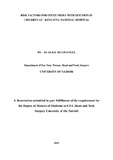| dc.description.abstract | Introduction: Otitis media with effusion is a multifactorial disease process involving immunological, infectious, anatomic, socioeconomic and genetic causes among other factors. Otitis media with effusion is a clinical entity defined as the presence of fluid in the middle ear behind an intact tympanic membrane without active inflammation. Its peak prevalence varies between 1.3% -31.3% according to different countries and this has been reported to be strongly associated with the presence of risk factors. Knowledge of risk factors for Otitis media with effusion may help to understand the causation, the prevention and hence the management of OME.
Study objective:The aim of this study was to determine if age, gender, day care center attendance, cigarette smoke, positive history of upper airway obstruction, adenoid hyperplasia, bottle feeding and history of recurrent acute otitis media are the risk factors associated with the occurrence of Otitis media with effusion in children at Kenyatta National Hospital
Study design: This was a Hospital based cross-sectional descriptive study
Study area: The study was carried out at Kenyatta National Hospital Ear Nose and Throat, Head and Neck Surgery Outpatient Clinic
Materials and Methods:A questionnaire was used to collect data on demographic and relevant history in 57 Children aged 7 years and less. The subjects were diagnosed by the principal researcher by using otoscopic examination as per OME study definition. Tympanographic assessment was carried out to confirm the presence of OME. Children with type B tympanograph were recruited into the study. Clinical data were collected on a preformatted questionnaire and descriptive analysis was performed in SPSS 21 version. Man-Whitney distribution test was used to calculate p-values and Spearman Chi-square test was used to calculate the Odd ratio.
Results: This study has helped to determine the risk factors associated with the occurrence of OME in 57 children aged of 7 years and less. The risk factors found significant were respectively age, gender, day-care center, parental smoking, presence of positive history of upper respiratory tract infection, adenoid hypertrophy and presence of acute otitis media in the last 3 months.
Conclusion: The above results have contributed to the occurrence of OME in children who were tested positive. These findings were noted potential to play an important role in the pathogenesis of the disease. Parents and caregivers must be informed about these highly modifiable risk factors. By this way, the development or delayed diagnosis of OME can be prevented | en_US |
| dc.description.department | a
Department of Psychiatry, University of Nairobi, ; bDepartment of Mental Health, School of Medicine,
Moi University, Eldoret, Kenya | |

